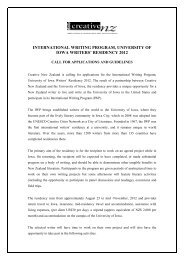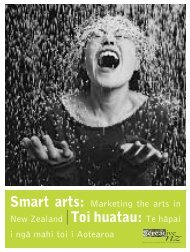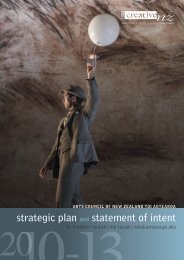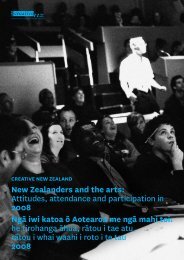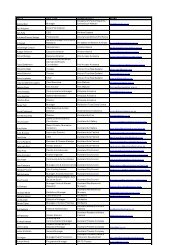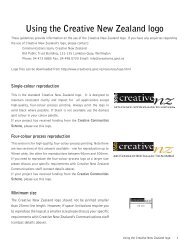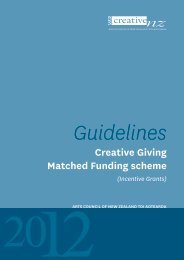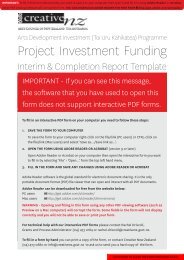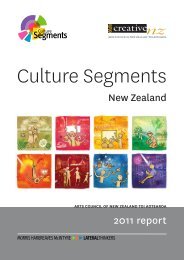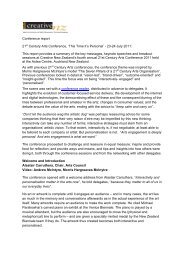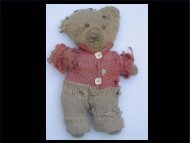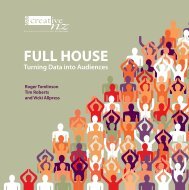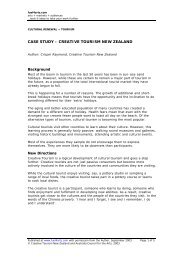relationship marketing – life in the trenches - Creative New Zealand
relationship marketing – life in the trenches - Creative New Zealand
relationship marketing – life in the trenches - Creative New Zealand
You also want an ePaper? Increase the reach of your titles
YUMPU automatically turns print PDFs into web optimized ePapers that Google loves.
fuel4arts.com<br />
arts + markets + audiences<br />
…tools & ideas to take your work fur<strong>the</strong>r<br />
RELATIONSHIP MARKETING<br />
RELATIONSHIP MARKETING <strong>–</strong> LIFE IN THE TRENCHES<br />
Author: Penn Trevella, Market<strong>in</strong>g Coord<strong>in</strong>ator, Royal <strong>New</strong> <strong>Zealand</strong> Ballet<br />
2003<br />
Introduction<br />
A 30 m<strong>in</strong>ute Google surf on <strong>relationship</strong> <strong>market<strong>in</strong>g</strong> yields a swag of articles with<br />
impressive, if not a little daunt<strong>in</strong>g, titles such as “How to Lap <strong>the</strong> Competition”,<br />
“Wow Your Customers”, “360-Degree Customer Care” and, drum roll please, “If<br />
<strong>the</strong> Phone R<strong>in</strong>gs, Answer It”.<br />
Flick<strong>in</strong>g through <strong>the</strong> articles my eyes beg<strong>in</strong> to glaze over with page after page of<br />
evangelical <strong>market<strong>in</strong>g</strong> speak and glorified tales of <strong>life</strong>-chang<strong>in</strong>g bus<strong>in</strong>ess to<br />
customer experiences such as <strong>the</strong> “heartwarm<strong>in</strong>g tale of a man, a lost luggage<br />
tag, and some fabulous brownies”.<br />
While <strong>the</strong> articles manage to heighten customer relations to <strong>the</strong> realm of trench<br />
warfare, what <strong>the</strong>y are say<strong>in</strong>g is one very simple th<strong>in</strong>g: <strong>the</strong> customer is <strong>the</strong> most<br />
important part of our bus<strong>in</strong>ess.<br />
What is Relationship Market<strong>in</strong>g<br />
Relationship <strong>market<strong>in</strong>g</strong>, or customer <strong>relationship</strong> management (CRM), is about<br />
develop<strong>in</strong>g service processes based on <strong>the</strong> pr<strong>in</strong>ciple that <strong>the</strong> customer and <strong>the</strong>ir<br />
needs are <strong>the</strong> central component from which your bus<strong>in</strong>ess activities evolve.<br />
While traditional <strong>market<strong>in</strong>g</strong> <strong>the</strong>ory focuses on bundl<strong>in</strong>g toge<strong>the</strong>r groups of<br />
customers with similar characteristics, <strong>relationship</strong> <strong>market<strong>in</strong>g</strong> recognises that<br />
each customer is a unique person with <strong>in</strong>dividual needs.<br />
Relationship <strong>market<strong>in</strong>g</strong> with<strong>in</strong> <strong>the</strong> context of <strong>the</strong> arts can be divided <strong>in</strong>to two<br />
areas of customer focus:<br />
- service quality and ensur<strong>in</strong>g customer satisfation throughout <strong>the</strong> organisation;<br />
and<br />
- enhanc<strong>in</strong>g <strong>the</strong> artistic experience that each customer receives.<br />
Published at www.fuel4arts.com with permission from <strong>the</strong> Author, July 2003 Page 1 of 6<br />
© Penn Trevella and Australia Council for <strong>the</strong> Arts, 2003
fuel4arts.com<br />
arts + markets + audiences<br />
…tools & ideas to take your work fur<strong>the</strong>r<br />
Relationship Market<strong>in</strong>g and <strong>the</strong> Arts<br />
Arts marketers know that <strong>the</strong>ir product has a number of unique characteristics<br />
that require different handl<strong>in</strong>g than traditional consumer products. These<br />
characteristics are ideally suited to a <strong>relationship</strong> <strong>market<strong>in</strong>g</strong> approach.<br />
Art is Intangible<br />
The experience of art is <strong>in</strong>tangible; <strong>the</strong>re is no ever last<strong>in</strong>g physical product.<br />
Once <strong>the</strong> curta<strong>in</strong> falls <strong>the</strong> show has gone for ever. Sure, you could come back to<br />
see <strong>the</strong> same show <strong>the</strong> follow<strong>in</strong>g night, but <strong>the</strong> experience will always be<br />
different. The visual arts are <strong>the</strong> same. Even though <strong>the</strong> work itself has a physical<br />
form, <strong>the</strong> real value is ultimately derived from <strong>the</strong> emotion that it stirs with<strong>in</strong> <strong>the</strong><br />
person gaz<strong>in</strong>g upon it, ra<strong>the</strong>r than physical ownership. Relationship <strong>market<strong>in</strong>g</strong> is<br />
an opportunity for arts marketers to enhance <strong>the</strong> emotional experience that <strong>the</strong>ir<br />
customers receive.<br />
Arts Involves Individual Interpretation<br />
Art is a personal journey. We all come from different backgrounds and all have<br />
vastly different collections of <strong>life</strong> experiences. An artistic work asks each<br />
<strong>in</strong>dividual to <strong>in</strong>terpret what it is present<strong>in</strong>g to us. The context for each <strong>in</strong>dividual’s<br />
<strong>in</strong>terpretation comes from <strong>the</strong> knowledge and experience <strong>the</strong>y have ga<strong>the</strong>red<br />
over <strong>the</strong>ir <strong>life</strong>time <strong>–</strong> this is why we all have different op<strong>in</strong>ions. Relationship<br />
<strong>market<strong>in</strong>g</strong> acknowledges that we are all different and recognises <strong>the</strong> need to<br />
provide an <strong>in</strong>formation system that caters to <strong>the</strong>se differences.<br />
Art Appeals to All<br />
Arts <strong>market<strong>in</strong>g</strong> is about access, enabl<strong>in</strong>g <strong>the</strong> greatest possible slice of <strong>the</strong><br />
population to experience what we have to offer. This means an arts organisation’s<br />
potential customers are of all ages and come from a range of cultural and<br />
educational backgrounds.<br />
Given this diverstity of backgrounds, <strong>the</strong> <strong>in</strong>formation required by customers for<br />
<strong>the</strong>m to make <strong>the</strong> decision to attend, and <strong>the</strong>n to maximise <strong>the</strong> personal benefit<br />
<strong>the</strong>y ga<strong>in</strong> from <strong>the</strong> experience, will vary immensely from person to person.<br />
Therefore arts orga<strong>in</strong>sations need a strategy that acknowledges that <strong>the</strong>y have a<br />
wide base of potential customers and enables <strong>the</strong>m to provide specific<br />
<strong>in</strong>formation to <strong>in</strong>dividual customers.<br />
The Enterta<strong>in</strong>ment Industry and Spend<strong>in</strong>g More Effectively<br />
“In fact, some marketers claim that as a result of chang<strong>in</strong>g households, complex<br />
products, new ways to shop and pay, <strong>in</strong>tense competition, and decl<strong>in</strong><strong>in</strong>g<br />
advertis<strong>in</strong>g effectiveness, mass <strong>market<strong>in</strong>g</strong> is obsolete.”<br />
- Kotler and Scheff, 1997.<br />
From sports and movies, to a night <strong>in</strong> watch<strong>in</strong>g <strong>the</strong> telly, <strong>the</strong> arts are now up<br />
aga<strong>in</strong>st all activities that people have to choose from <strong>in</strong> <strong>the</strong>ir leisure time. Arts<br />
marketers need to develop smarter and more adaptable tools to be able to match<br />
it with competitors with far greater resources.<br />
In an <strong>in</strong>creas<strong>in</strong>gly expensive marketplace marketers must be able to measure <strong>the</strong><br />
effectiveness of <strong>the</strong> tools and mediums <strong>the</strong>y are us<strong>in</strong>g. Traditional mass mediums<br />
such as pr<strong>in</strong>t advertis<strong>in</strong>g, radio and television are undoubtedly effective tools for<br />
rais<strong>in</strong>g awareness but research shows that awareness alone is not enough to send<br />
customers scurry<strong>in</strong>g to <strong>the</strong> box office.<br />
Published at www.fuel4arts.com with permission from <strong>the</strong> Author, July 2003 Page 2 of 6<br />
© Penn Trevella and Australia Council for <strong>the</strong> Arts, 2003
fuel4arts.com<br />
arts + markets + audiences<br />
…tools & ideas to take your work fur<strong>the</strong>r<br />
As advertis<strong>in</strong>g rates <strong>in</strong>crease and <strong>the</strong> sheer quantity of advertis<strong>in</strong>g sky rockets,<br />
organisations must review <strong>the</strong> emphasis and f<strong>in</strong>ancial commitment <strong>the</strong>y give to<br />
ga<strong>in</strong><strong>in</strong>g mass market exposure and look more seriously at communication<br />
techniques that are more directly and specifically targeted at <strong>the</strong>ir customers.<br />
Relationship <strong>market<strong>in</strong>g</strong> based tools such as opt-<strong>in</strong> email systems and customer<br />
focused newsletters are examples of communications that can be delivered<br />
directly to your targeted audience and designed specifically for <strong>the</strong>ir needs.<br />
Relationship Market<strong>in</strong>g as a Commitment to Service Quality<br />
Relationship <strong>market<strong>in</strong>g</strong> <strong>in</strong>volves implement<strong>in</strong>g specific service quality processes<br />
designed to ensure on-go<strong>in</strong>g customer satisfaction.<br />
A person’s <strong>relationship</strong> with an artistic product beg<strong>in</strong>s at that first moment of<br />
awareness <strong>–</strong> catch<strong>in</strong>g a glimpse of a poster on <strong>the</strong> street, read<strong>in</strong>g an article <strong>in</strong> a<br />
magaz<strong>in</strong>e, hear<strong>in</strong>g a friend talk enthusiastically about a show. Between that<br />
moment and <strong>the</strong> actual artistic experience <strong>the</strong>re are a multitude of <strong>in</strong>teractions,<br />
both direct and <strong>in</strong>direct, that need to be managed effectively and efficiently to<br />
ensure that <strong>the</strong> customer will be receptive to a positive experience.<br />
From a customer’s po<strong>in</strong>t of view, <strong>the</strong> artistic product and <strong>the</strong>ir reaction to it is<br />
what matters. Therefore, as marketers, it is our job to create an environment<br />
that gives each customer <strong>the</strong> opportunity to receive <strong>the</strong> best possible experience.<br />
The battle for customers can be so hard fought that it feels as though you have<br />
had to personally persuade each of <strong>the</strong>m to come through <strong>the</strong> doors. Hav<strong>in</strong>g<br />
endured such a struggle, it is heart-wrench<strong>in</strong>g to receive compla<strong>in</strong>ts of ticket<strong>in</strong>g<br />
errors, rude <strong>the</strong>atre staff or unacceptable l<strong>in</strong>es at <strong>the</strong> bar at <strong>in</strong>terval. Unfortunate<br />
<strong>in</strong>cidents ta<strong>in</strong>t <strong>the</strong> experience of an even<strong>in</strong>g at <strong>the</strong> <strong>the</strong>atre and subsequently<br />
effect <strong>the</strong> customer’s will<strong>in</strong>gness to attend <strong>in</strong> <strong>the</strong> future.<br />
The artistic product will always be at <strong>the</strong> core of what we do as arts marketers.<br />
However, acknowledg<strong>in</strong>g <strong>the</strong> importance of service quality and customer<br />
satisfaction, as <strong>the</strong> foundation for <strong>the</strong> presentation of an artistic experience,<br />
<strong>in</strong>creases <strong>the</strong> likelihood of customers return<strong>in</strong>g <strong>in</strong> <strong>the</strong> future.<br />
Service Quality <strong>–</strong> <strong>the</strong> Build<strong>in</strong>g Blocks<br />
Every <strong>in</strong>teraction that you have with a customer adds to <strong>the</strong> mental image<br />
(position<strong>in</strong>g, <strong>in</strong> <strong>market<strong>in</strong>g</strong> l<strong>in</strong>go) <strong>the</strong>y reta<strong>in</strong> of your organisation. Therefore,<br />
every <strong>in</strong>teraction is an opportunity to enhance <strong>the</strong> customer’s mental image of<br />
your organisation. Alternatively, a bad experience can undo all of <strong>the</strong> good work<br />
that has been done.<br />
Map out all <strong>the</strong> possible po<strong>in</strong>ts of contact between your organisation and <strong>the</strong><br />
customer from <strong>the</strong> first moment <strong>the</strong>y become aware of your show to when <strong>the</strong>y’re<br />
<strong>in</strong> <strong>the</strong> <strong>the</strong>atre. These po<strong>in</strong>ts of <strong>in</strong>teraction range from personal contact, such as<br />
ticket sellers, ushers and <strong>the</strong>atre staff, to event list<strong>in</strong>gs on <strong>the</strong> Internet, or<br />
advertis<strong>in</strong>g <strong>in</strong> pr<strong>in</strong>t, TV or radio.<br />
By go<strong>in</strong>g through this process you can quickly see that <strong>the</strong>re are numerous<br />
potential po<strong>in</strong>ts of <strong>in</strong>teraction that a customer must navigate before <strong>the</strong>y make it<br />
to your show. The challenge is to develop processes to ensure <strong>the</strong> highest<br />
possible levels of service quality at each po<strong>in</strong>t.<br />
Published at www.fuel4arts.com with permission from <strong>the</strong> Author, July 2003 Page 3 of 6<br />
© Penn Trevella and Australia Council for <strong>the</strong> Arts, 2003
fuel4arts.com<br />
arts + markets + audiences<br />
…tools & ideas to take your work fur<strong>the</strong>r<br />
Relationship Market<strong>in</strong>g to Enhance <strong>the</strong> Artistic Experience<br />
The second area of <strong>relationship</strong> <strong>market<strong>in</strong>g</strong> particularly relevent to <strong>the</strong> arts<br />
<strong>in</strong>volves develop<strong>in</strong>g ways <strong>in</strong> which <strong>the</strong> actual experience can be enhanced.<br />
For arts marketers this means provid<strong>in</strong>g customers with <strong>the</strong> <strong>in</strong>formation that <strong>the</strong>y<br />
as <strong>in</strong>dividuals require to maximise <strong>the</strong>ir personal experience.<br />
I first started th<strong>in</strong>k<strong>in</strong>g about <strong>the</strong> use of <strong>in</strong>formation as a tool for enhanc<strong>in</strong>g<br />
customer experience a couple of years ago when we conducted focus groups with<br />
subscription ticket purchasers. Our subscriber base had stagnated. So we decided<br />
to ask our customers how we could revitalise <strong>the</strong> way we marketed our<br />
subscription packages.<br />
Sitt<strong>in</strong>g <strong>in</strong> on <strong>the</strong>se sessions, hear<strong>in</strong>g <strong>the</strong> commitment that many of <strong>the</strong>se people<br />
showed to <strong>the</strong> art form and <strong>the</strong> pride which <strong>the</strong>y felt towards our company, was a<br />
humbl<strong>in</strong>g experience.<br />
Two th<strong>in</strong>gs surprised me: <strong>the</strong> level of knowledge <strong>the</strong>y had built up over <strong>the</strong> years<br />
of attend<strong>in</strong>g our shows, and <strong>the</strong> types of <strong>in</strong>formation that <strong>the</strong>y were particularly<br />
<strong>in</strong>terested <strong>in</strong>.<br />
Many had specific <strong>in</strong>formation needs, such as listen<strong>in</strong>g to <strong>the</strong> musical score,<br />
want<strong>in</strong>g to know more about <strong>the</strong> history of <strong>the</strong> production or watch<strong>in</strong>g videos of<br />
<strong>the</strong> choreographers previous work, and before attend<strong>in</strong>g each show researched<br />
<strong>the</strong>ir personal areas of <strong>in</strong>terest. They were acumulat<strong>in</strong>g a level of <strong>in</strong>formation that<br />
enabled <strong>the</strong>m to receive <strong>the</strong> maximum level of personal return from <strong>the</strong><br />
performance.<br />
While I’m aware that subscribers are our most committed customers and<br />
probably quite different from <strong>the</strong> bulk of our s<strong>in</strong>gle ticket purchas<strong>in</strong>g customers, it<br />
made me consider <strong>the</strong> type of <strong>in</strong>formation we were provid<strong>in</strong>g and <strong>the</strong> way we <strong>in</strong><br />
which we were provid<strong>in</strong>g it.<br />
How many people were sitt<strong>in</strong>g <strong>in</strong> <strong>the</strong> darkened <strong>the</strong>atre, attend<strong>in</strong>g <strong>the</strong>ir first ever<br />
ballet, hunched over a programme try<strong>in</strong>g to make sense of what was happen<strong>in</strong>g<br />
on stage<br />
In order to better understand how <strong>in</strong>formation could add to <strong>the</strong> enjoyment of our<br />
shows we embarked upon a number of projects:<br />
- A quantitative research project explor<strong>in</strong>g ballet knowledge, motivations for<br />
attend<strong>in</strong>g, current <strong>in</strong>formation sources and areas of particular <strong>in</strong>terest to<br />
customers.<br />
- Analysis of web site statistics to determ<strong>in</strong>e what <strong>in</strong>formation current users<br />
were access<strong>in</strong>g.<br />
- Relaunch<strong>in</strong>g our web site with <strong>in</strong>creased focus on dancer <strong>in</strong>formation, daily<br />
cast<strong>in</strong>g details, up-to-date images and reviews, and comprehensive book<strong>in</strong>g<br />
<strong>in</strong>formation.<br />
- Daily updat<strong>in</strong>g website content to encourage customers to visit <strong>the</strong> site<br />
more often.<br />
- Establish<strong>in</strong>g an e-bullet<strong>in</strong> with unique beh<strong>in</strong>d <strong>the</strong> scenes <strong>in</strong>formation to<br />
br<strong>in</strong>g customers closer to <strong>the</strong> company.<br />
Published at www.fuel4arts.com with permission from <strong>the</strong> Author, July 2003 Page 4 of 6<br />
© Penn Trevella and Australia Council for <strong>the</strong> Arts, 2003
fuel4arts.com<br />
arts + markets + audiences<br />
…tools & ideas to take your work fur<strong>the</strong>r<br />
Customers Know What They Want - Give it to Them<br />
"A Relationship Market<strong>in</strong>g <strong>in</strong>itiative should start with <strong>the</strong> recognition that<br />
technology now enables companies to understand, motivate and serve <strong>the</strong><br />
<strong>in</strong>dividual customer as never before."<br />
- Ian Gordon, Relationship Market<strong>in</strong>g<br />
One-on-one communication is <strong>the</strong> most effective <strong>relationship</strong> <strong>market<strong>in</strong>g</strong><br />
technique. If arts organisations had unlimited resources <strong>the</strong>y would be <strong>in</strong> personal<br />
contact with each customer on a regular basis, <strong>in</strong>form<strong>in</strong>g <strong>the</strong>m about upcom<strong>in</strong>g<br />
shows, pass<strong>in</strong>g on <strong>in</strong>formation <strong>the</strong>y know is of <strong>in</strong>terest to <strong>the</strong>m and answer<strong>in</strong>g<br />
any questions.<br />
With limited resources, <strong>the</strong> arts have traditionally relied on newsletters, email<br />
updates more recently, and direct mail to stay <strong>in</strong> touch. While <strong>the</strong>se methods are<br />
a cost efficient and effective means of communication, <strong>the</strong>y are not completely<br />
ideal, as <strong>the</strong>y do not allow <strong>the</strong> customer to have any say <strong>in</strong> <strong>the</strong> type of<br />
<strong>in</strong>formation <strong>the</strong>y receive.<br />
This is a major disadvantage as <strong>the</strong> <strong>in</strong>creas<strong>in</strong>g amount of <strong>in</strong>formation people are<br />
be<strong>in</strong>g bombarded with on a day-to-day basis means communication must have<br />
real relevance to grab attention.<br />
Unless you are prepared to produce pr<strong>in</strong>t material customised to <strong>in</strong>dividual<br />
customers, <strong>the</strong> <strong>in</strong>ternet and email is <strong>the</strong> <strong>relationship</strong> <strong>market<strong>in</strong>g</strong> communication<br />
channel.<br />
Technology<br />
While collect<strong>in</strong>g email addresses and add<strong>in</strong>g <strong>the</strong>m to a database is not new, best<br />
practice CRM allows customers <strong>in</strong>put <strong>in</strong>to <strong>the</strong> type of communications <strong>the</strong>y<br />
receive.<br />
Opt-<strong>in</strong> email systems, where customers can build and alter <strong>the</strong>ir personal profiles,<br />
allow far more personally specific communication to be created at very low cost.<br />
Typically, by access<strong>in</strong>g <strong>the</strong>ir profile, customers are able to select <strong>the</strong> type of<br />
<strong>in</strong>formation <strong>the</strong>y receive, <strong>the</strong> frequency, and <strong>the</strong> email format <strong>the</strong>y receive <strong>in</strong> <strong>the</strong><br />
future.<br />
Tak<strong>in</strong>g it to ano<strong>the</strong>r level, this technology can also now be <strong>in</strong>tegrated with text<br />
messag<strong>in</strong>g services so customers can be reached while <strong>the</strong>y’re on <strong>the</strong> move.<br />
Potentially <strong>the</strong> most powerful tool for <strong>relationship</strong> <strong>market<strong>in</strong>g</strong> <strong>in</strong> <strong>the</strong> arts though, is<br />
<strong>the</strong> <strong>in</strong>tegration of email and text messag<strong>in</strong>g communication with <strong>the</strong> box office<br />
system.<br />
Comb<strong>in</strong><strong>in</strong>g box office data such as previous shows attended, <strong>the</strong> type of tickets<br />
purchased and <strong>the</strong> tim<strong>in</strong>g of <strong>the</strong> transaction, with <strong>in</strong>formation collected through<br />
each customer’s database profile, enables marketers to create even more highly<br />
personalised, targeted, and persuasive communications that can be sent at very<br />
low cost.<br />
In addition to provid<strong>in</strong>g ano<strong>the</strong>r layer of customer <strong>in</strong>formation, one of <strong>the</strong> biggest<br />
advantages <strong>in</strong> l<strong>in</strong>k<strong>in</strong>g customer communications with <strong>the</strong> box office is <strong>the</strong> capacity<br />
for call to action promotional offers to be far more timely and accurate than non<br />
box office based data.<br />
Published at www.fuel4arts.com with permission from <strong>the</strong> Author, July 2003 Page 5 of 6<br />
© Penn Trevella and Australia Council for <strong>the</strong> Arts, 2003
fuel4arts.com<br />
arts + markets + audiences<br />
…tools & ideas to take your work fur<strong>the</strong>r<br />
As all ticket purchase transactions are conducted through <strong>the</strong> box office system,<br />
<strong>the</strong> <strong>in</strong>formation you are work<strong>in</strong>g with is as “real time” as possible. Access to this<br />
up-to-date sales <strong>in</strong>formation significantly reduces <strong>the</strong> chances of customers be<strong>in</strong>g<br />
sent sales offers when <strong>the</strong>y have already purchased tickets to <strong>the</strong> show, and<br />
<strong>the</strong>refore <strong>in</strong>creases <strong>the</strong> likely success of <strong>the</strong> offer.<br />
Every seat that goes unsold represents lost potential revenue for arts<br />
organisations. Access to <strong>the</strong>se types of technology and communication tools,<br />
comb<strong>in</strong>ed with smart th<strong>in</strong>k<strong>in</strong>g, gives arts marketers <strong>the</strong> ability to stimulate<br />
customer demand right up until <strong>the</strong> moment <strong>the</strong> curta<strong>in</strong> goes up.<br />
Useful Web L<strong>in</strong>ks and Publications<br />
http://www.bornkick<strong>in</strong>g.com/benefits.php<br />
http://www.clickz.com/<br />
http://www.crm2day.com/<br />
http://www.emarketer.com/<br />
http://www.peoplesoft.com/media/en/pdf/crm/olm_ds_0603.pdf<br />
Gordon, I. (1998), Relationship Market<strong>in</strong>g: <strong>New</strong> Strategies, Techniques and<br />
Technologies to W<strong>in</strong> <strong>the</strong> Customers You Want & Keep Them Forever, John Wiley.<br />
Kotler, P. and Scheff, J. (1997), Stand<strong>in</strong>g Room Only, Harvard Bus<strong>in</strong>ess School<br />
Press, Boston, MA.<br />
Published at www.fuel4arts.com with permission from <strong>the</strong> Author, July 2003 Page 6 of 6<br />
© Penn Trevella and Australia Council for <strong>the</strong> Arts, 2003



